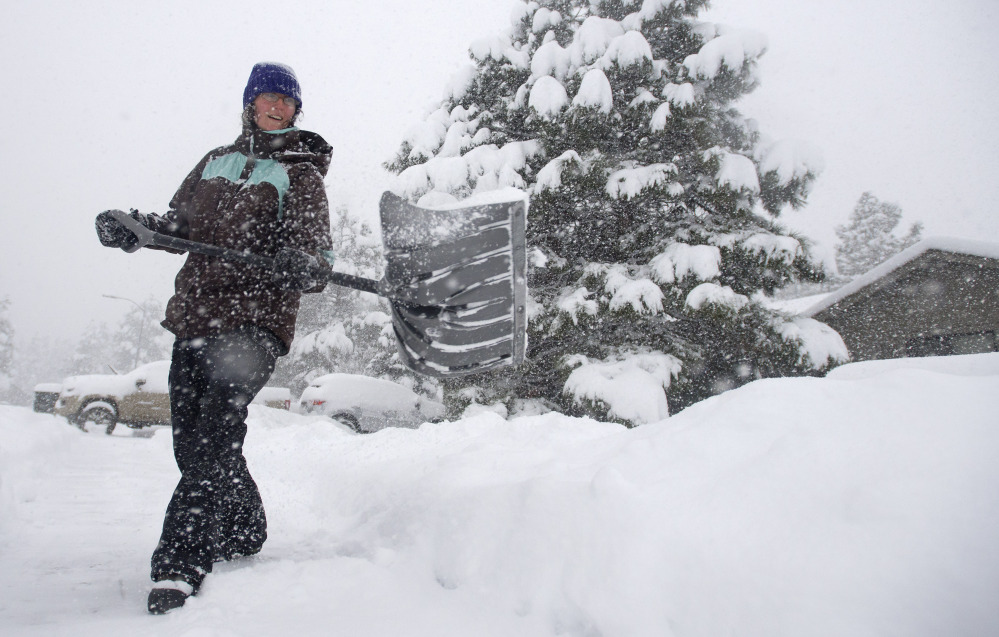WASHINGTON — Get ready for weather whiplash as powerful climatic forces elbow each other for starring roles in a weird winter show.
The spine-chilling polar vortex is taking center stage in Europe and bringing persistent cold to much of North America – except in Hollywood, where soggy El Nino won’t give up the spotlight.
After El Nino delivered a balmy Christmas Eve to the eastern U.S. and shattered national records with a warm, wet and wild December, Minnesota may host one of the coldest NFL playoff games in history this Sunday, with wind chills around 20 below, meteorologists predict.
“The biggest thing is this whiplash,” said University of Oklahoma meteorology professor Jason Furtado. “It’s going to be a shock for people.”
The center of the cold blast starts this weekend in the U.S. in the upper Midwest, and then moves to the Hudson Bay area next week, while in Europe it starts in the east and north and then spreads, Furtado said. Europe may have to get used to temperatures 20 or so degrees below normal.
THE POLAR VORTEX AND EL NINO
“Temperature will be dominated by the impact of the polar vortex,” said Judah Cohen, seasonal forecast chief for the private Atmospheric and Environmental Research company outside Boston. It will feel similar to 2013 and 2014, he said.
Americans became painfully familiar with the polar vortex during those winters. This time, America’s winter temperatures will depend on when the wet and warm El Nino pushes itself back to prominence, Furtado said.
“We have all of these large and unusual events happening all at the same time and I don’t think it has ever happened before,” said Rutgers University climate scientist Jennifer Francis.
The main event is El Nino. This natural warming of the central tropical Pacific occurs every two to seven years or so, and changes weather worldwide, especially in the Americas and Asia. It is closely associated with heavy rain in California, and general warming. It has less effect in Europe because that’s farther away. With its flipside, La Nina, it is known as the El Nino Southern Oscillation, and it lasts about a year.
THE ARCTIC OSCILLATION
Playing off against El Nino is the Arctic Oscillation, and its index measures differences in atmospheric pressure between the Arctic and mid-latitudes. When the AO is positive in the winter, polar air stays trapped up north and the weather is relatively mild farther south. When the AO is negative, the cold arctic air escapes and plunges into lower latitudes, treating the United States and Europe to the polar vortex – a swirling air mass that carries spine-chilling temperatures.
Will the polar vortex hold the stage for weeks or months? Will the cold AO and wet El Nino combine for whopper snowstorms?
Rutgers’ Francis doesn’t think the moisture and the cold can keep avoiding each other, saying “we’re going to have major major dumps of snow. We just don’t know where.”
Furtado predicts El Nino will push aside the cold in America, but not in Europe, where it has less of an influence. Cohen is less certain about what will happen as these forces morph and interact over time.
“There’s a lot going on; the weather has been crazy,” Cohen said. “Expect the unexpected.”
Copy the Story LinkSend questions/comments to the editors.



Success. Please wait for the page to reload. If the page does not reload within 5 seconds, please refresh the page.
Enter your email and password to access comments.
Hi, to comment on stories you must . This profile is in addition to your subscription and website login.
Already have a commenting profile? .
Invalid username/password.
Please check your email to confirm and complete your registration.
Only subscribers are eligible to post comments. Please subscribe or login first for digital access. Here’s why.
Use the form below to reset your password. When you've submitted your account email, we will send an email with a reset code.